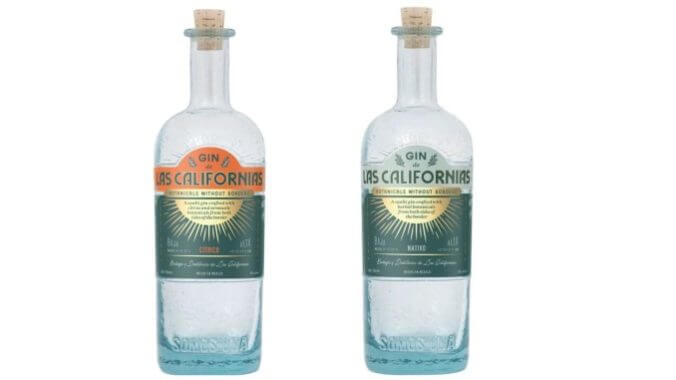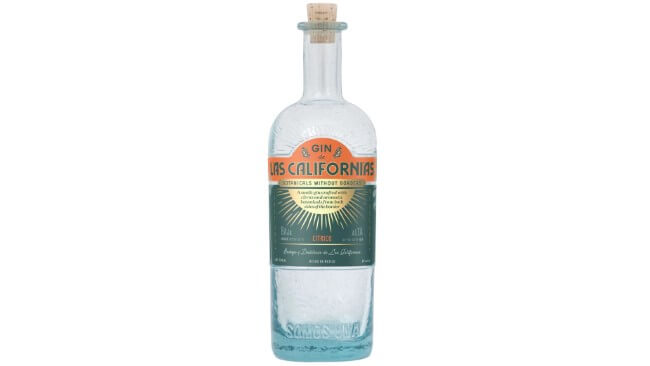Tasting: 2 Fresh, Coastal Gins from Las Californias
Photos via Las Californias
Gin is a spirit that practically any functioning distillery can make. It’s not difficult to get ahold of some juniper, some citrus, a few peppercorns, and boom—you’ve got yourself your own rote little take on London dry gin. One could consider the relative ease and speed of making gin as a boon to the would-be distillers out there—you can turn around a batch quickly, and consumers are fairly accepting of a “more of the same” approach. All in all, gin is pretty safe, and as a result it’s unsurprising that many young distilleries lean heavily on it.
Truly creating a gin flavor profile that captures the soul and terroir of a region, however, is a much more protracted and quixotic affair. As a spirit, gin naturally invites this type of contemplation—it derives almost all of its flavor from the infusion of botanicals, our overarching term for the array of fruit, herbs and spices that make up the flavor profile. And those botanicals need to come from somewhere. Sure, a distillery in rural Iowa can simply import juniper and spices from all over the world to create that blend, but there’s something more satisfying in the romance of a gin’s botanicals reflecting the land that its distillery calls home. Obviously, this isn’t really possible for every distillery, but it is a distinct possibility in California, a state with access to a wealth of flavorful botanicals.
That’s the philosophy at the heart of Las Californias, a young gin brand paying homage to the botanicals and biological diversity of not just the state of California, but the neighboring regions of Mexico. Says the brand: “Our gins are an exploration of the unconstrained cultural and biological diversity that flows across this region today — and, ultimately, what can transpire when we transcend artificial borders. Hyper-local foraging across this border resulted in the perfect harmony—from the colder waters in Alta which provide the most flavorful kelp, to a more floral white sage in the dry deserts of Baja.”
Las Californias, then, is the fusion of California and Mexican terroir. It’s not exactly a brand new idea, of course—one can’t help but be reminded of the classic, flagship Terroir Gin of the groundbreaking flavor pioneers at St. George Spirits, which also celebrates California flora—but the focus on not one but two regions here gives Las Californias a vital tool to help it stand out. I tasted both of their core expressions: The botanical-driven Nativo, and the citrus-focused Citrico.
So with that said, let’s get to tasting.
Las Californias Nativo Gin

Las Californias describes the inspiration of Nativo as being “an evergreen gin distilled with endemic botanicals from both sides of the border that predate human interaction with the Las Californias territory.” It is, therefore, a celebration of the landscape in the truest sense, including those botanicals that were naturally put on Earth rather than those that humans brought along with them. This one weighs in at a slightly higher 42% ABV (84 proof), compared to the mere 40% ABV (80 proof) of the Citrico.
On the nose, Nativo is quite perfumey and distinct, with qualities that are resinous, herbal and fruity all at once. There’s a suggestions of wild berries, along with sage, licorice and sweetly herbaceous tones. I’m reminded of various herbal liqueurs almost more than I am gin—Nativo is not super upfront with classic juniper tones, but is almost more evocative of amaro or Chartreuse.
On the palate, this is really pretty assertive and punchy for being a mere 42% ABV, not in the sense of strong ethanol but a diverse array of botanical-driven flavors. Herbal, grassy and woody, there’s an exotic wildness to this spirit that can’t help but put you in the mind of a California forest scape, even if you’ve never been to one. The herbal, earthiness is given a liqueur-like consistency by significant residual sweetness, but at the same time there’s also a moderate bitterness—possibly imparted by the hops in the botanical blend—that keeps things from registering as sickly or cloying. Again, I’m reminded of nothing so much as gin crossed with say, Yellow Chartreuse, in a pleasant way. Regardless, this is a very distinctive gin that no one would accuse of being an imitation of anyone else’s product, and that’s a win in my book. I’ll be very curious to see how this one shines through in various classic gin cocktails.
Las Californias Citrico Gin

The reality of selling a product like gin in the modern market is that you can’t simply offer a single brand in the mold of Las Californias Nativo. As intriguing as that bottle is, the consumer is always going to demand something fruitier and more familiar, and “citrus” is a go-to for the entire alcohol industry to deliver that familiarity. This is no doubt the bottle that can be recommended to the vodka drinkers in the house when they ask for something “light.” Las Californias describes it as “a citrus gin distilled with botanicals from both sides of the border that were brought to the Las Californias territory by cultures transcending borders through migration.”
Still, there are some interesting and unexpected botanicals at play in Citrico, ranging from fruit such as apricots and figs to more vegetal players like citrus leaves or grape leaf. Additional botanicals include the likes of almond and lemongrass, although you can be certain that citrus will no doubt take the reins.
And yeah, it definitely does. The nose of Citrico celebrates over-the-top citrus notes, with lots of grapefruit candy and Mandarin orange, evoking orange LifeSavers candy. There are faint impressions of more herbal tones on the nose, but it’s hard to get at them past the wall of friendly, inviting citrus. “New Western” gin indeed.
On the palate, though, Citrico actually turns more dry than you’d probably be expecting from the raucous citrus of the nose—it still evokes orange creamsicle, but does it with a bit more deftness and elegance than I was expecting. I’m getting light pine needles and more of that sweet licorice note here as well. It’s certainly not bad, but it’s not as complex or soulful as the botanical blend of the Nativo. It is what it is; the gin of the group made for drinkers who would prefer to get citrus into their drink via the gin than by simply adding fresh citrus juice.
All in all, though, this is a pretty impressive duo of new world gins, showing a deft hand for both creating a product that evokes the landscape, and boldly exploring beyond the traditional gin flavor profile (via the Nativo). If you love the great outdoors of California and Mexico, it should certainly be on your list to check out.
Jim Vorel is a Paste staff writer and resident liquor geek. You can follow him on Twitter for more drink writing.







































